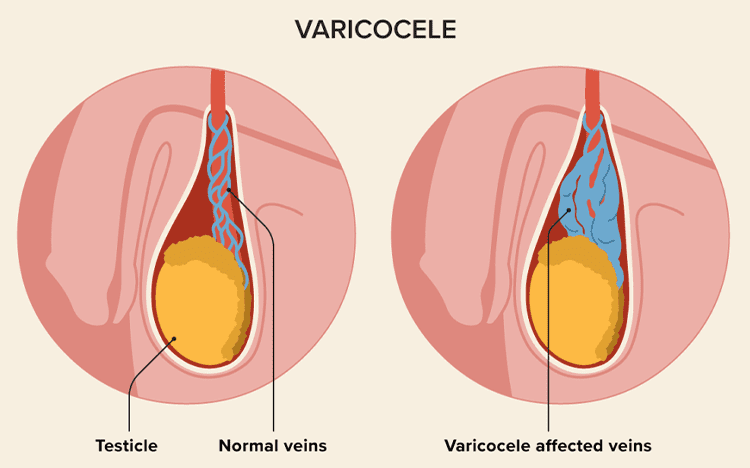A varicocele is an enlargement of the veins within the loose bag of skin that holds your testicles (scrotum). It is similar to a varicose vein you might see in your leg. This medical condition is a common cause of low sperm production and decreased sperm quality, which can cause infertility.
SYMPTOMS OF VARICOCELE:
- A Scrotal Mass
- Heavy Sensation
- Enlarged Veins
- Dull or Sharp Pain
- Infertility Issues.
Varicocele is typically asymptomatic, but it may become more visible over time. When a varicocele reaches a certain size, men may begin to experience symptoms.
It is believed to be caused by defective valves in the veins within the scrotum, just above the testicles. Normally, these valves regulate the flow of blood to and from the testicles. When normal flow doesn’t occur, the blood backs up, causing the veins to dilate (enlarge). This medical condition mostly occurs during the puberty, when the testicles are seeing maximized growth and need the most blood. In about 85% of cases, it occurs in the left testicle area.
Microscopic ligation of varicocele:
A varicocelectomy is the most common procedure performed to correct issues with varicoceles. With microscopic varicocele surgery, a high-powered surgical microscope is used to perform the operation. This type of surgery allows for a better view of the affected area.
Varicocelectomy is a safe procedure that has a high chance of improving your fertility and reducing complications of blocked blood flow into your reproductive organs. As with any surgery, there are some risks, and this procedure may not be able to fully restore your fertility.
The spermatic cord is dissected to access the abnormal veins, which are sealed or tied. Blood flow is then redirected away from the affected area and diverted to the pelvis or inner thigh.
Any surgery has some risk, such as bleeding and/or infection at the incision site. But there are also some major complications specific to varicocele surgery that you should be aware of:
Varicocele recurrence can be due to incomplete blockage of the veins that are causing the varicocele. This may result in persistent symptoms and problems with fertility.
Hydrocele formation, or a collection of fluid in or around the scrotum, results from the disruption of the lymphatic flow. Hydroceles can become large and cause pressure in the scrotum. Rarely, one can rupture. Surgery or drainage may be needed to correct a hydrocele.
Testicular artery ligation, or the accidental tying off of the blood flow to the testicle, can occur with some surgical approaches. There are concerns that this may result in testicular atrophy and decreased testicular function, such as lower testosterone levels and decreased sperm quality.


